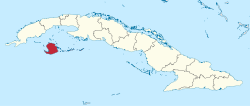This article needs additional citations for verification. (February 2020) |
Isla de la Juventud | |
|---|---|
 Regional map | |
 Isla de la Juventud in red | |
| Country | |
| Capital | Nueva Gerona |
| Area | |
• Total | 2,419 km2 (934 sq mi) |
| Population (2023 (onei))[2] | |
• Total | 76,154 |
| • Density | 31/km2 (82/sq mi) |
| Time zone | UTC-5 (EST) |
| Area code | +53-46 |
| HDI (2019) | 0.832[3] very high · 2nd of 16 |
| Website | www |

Isla de la Juventud[4] (Spanish pronunciation: [ˈisla ðe la xuβenˈtuð]; English: Isle of Youth) is the second-largest Cuban island (after Cuba's mainland) and the seventh-largest island in the West Indies (after mainland Cuba itself, Hispaniola, Jamaica, Puerto Rico, Trinidad, and Andros Island). The island was called the Isle of Pines (Spanish: Isla de Pinos) until 1978. It has an area 2,200 km2 (850 sq mi) and is 50 km (31 mi) south of the island of Cuba, across the Gulf of Batabanó. The island lies almost directly south of Havana and Pinar del Río and is a Special Municipality (2,419 km2 (934 sq mi)), not part of any province and is therefore administered directly by the central government of Cuba. The island has only one municipality, also named Isla de la Juventud.
The largest of the 350 islands in the Canarreos Archipelago (Archipiélago de los Canarreos), the island had an estimated population of 83,544 in 2019.[5] The capital and largest city is Nueva Gerona in the north, and the second largest and oldest city is Santa Fe in the interior. Other communities include Columbia, La Demajagua (formerly Santa Bárbara), Mac Kinley, Cuchilla Alta, Punta del Este, Sierra de Caballos and Sierra de Casas.[citation needed]
- ^ "Lugar que ocupa el territorio según la superficie y la población" (PDF). Una MIRADA a Cuba (in Spanish). Oficina Nacional de Estadísticas. Cuba. 2010.
- ^ 2012 Official Census Archived November 10, 2013, at the Wayback Machine | Province, City and ethnic group
- ^ "Sub-national HDI - Area Database - Global Data Lab". hdi.globaldatalab.org. Retrieved January 24, 2022.
- ^ Directorate of Intelligence (August 16, 2007). "The World Factbook — Cuba". Retrieved September 3, 2007.
- ^ "Statistical Yearbook of Cuba Population 2020 Edition January-December 2019" (PDF). oficina nacional de estadística e información. Retrieved October 7, 2020.
